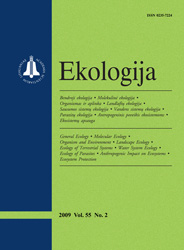
ISSN 0235-7224
ISSN 2029-0586 (online)
|
2010 m. Nr. 3-4
 Radiological investigation of wood used for combustion
Rima LADYGIENĖ, Asta ORENTIENĖ, Laima PILKYTĖ, Auksė SKRIPKIENĖ, Vida ŽUKAUSKAITĖ, Remigijus KIEVINAS
The aim of this study was evaluation of public radiological risk due to the use of wood fuel in combustion power plants. 137Cs and 90Sr concentrations were measured in wood fuel and its combustion products from the local markets and manufacturers. The measurement results were used to assess the effective dose for the critical group members in order to estimate the radiological effect of the effluents from combustion power plant stacks on habitants living in the surroundings of such plants. Evaluation of 137Cs concentration in the wood fuel that can be imported without alarm at border radiation gates was performed using modelling.
A number of wood fuel samples were analyzed. The activity concentration of 137Cs in wood fuel products as well as in ashes was determined using gamma spectrometers with high purity germanium detectors. Wood fuels were burned at 400 °C until constant weight. 90Sr activity concentration in ashes was determined with a liquid scintillation counter after radiochemical separation. A conservative dose assessment model was applied to evaluate the effective dose from the radioactive effluents to critical group members. The modelling of dose rate for wood contaminated by 137Cs was performed using the Visiplan suite 4.0 3D ALARA planning tool.
The results of radiological investigation showed that the maximum value of 137Cs activity concentration in the wood fuel of Lithuanian origin did not exceed 18 Bq/kg. The highest 137Cs activity concentration – 160 Bq/kg – was detected in pellets imported from Ukraine. 137Cs activity concentrations in wood fuel combustion products from Lithuania and Ukraine were 2 340 ± 220 Bq/kg and 9 800 ± 700 Bq/kg, respectively. The activity concentration of 90Sr was lower than that of 137Cs. The evaluation of the effective dose for the critical group members showed that the exposure due to 137Cs and 90Sr emission from the stacks of wood combustion power plants did not exceed 10 μSv per year, even if the plant used mostly contaminated wood fuel. The modelling revealed that wood fuel products containing higher than 3.2 Bq/g activity concentrations of 137Cs may give alarm at the borders with the alarm level of 0.2 μGy/h, whereas wood fuel with a lower activity concentration of 137Cs can pass the European border. Combustion products of such wood fuel may give 137Cs activity concentrations higher than the exemption level (10 Bq/g). Keywords: 137Cs and 90Sr, wood fuel, exposure, exemption level, emission
|
Issues:
2011 - Vol.57 No. 1, No. 22010 - Vol.56 No. 1-2, No. 3-42009 - Vol.55 No. 1, No. 2, No. 3-42008 - Vol.54 No. 1, No. 2, No. 3, No. 42007 - Vol.53 No. 1, No. 2, No. 2.priedas, No. 3, No. 42006 No. 1, No. 2, No. 3, No. 42005 No. 1, No. 2, No. 3, No. 42004 No. 1, No. 2, No. 3, No. 42003 No. 1, No. 2, No. 3, No. 42002 No. 1, No. 2, No. 3, No. 42001 No. 1, No. 2, No. 3, No. 4 |
